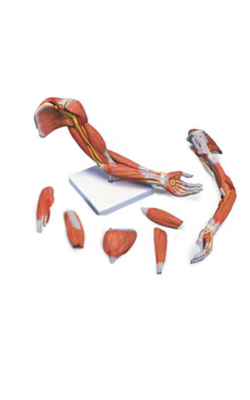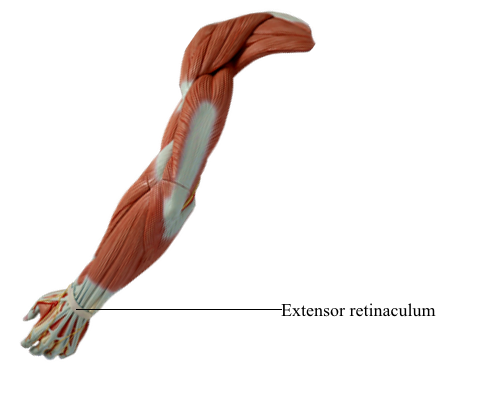Main Model

5 Extensor retinaculum

Fascia of Upper Limb
Deep to the skin is (1) subcutaneous tissue (superficial fascia) containing fat, and (2) deep fascia compartmentalizing and investing the muscles. If no structure (muscle, tendon, or bursa, for example) intervenes between the skin and bone, the deep fascia is usually attached to bone.
The fascia of the pectoral region is attached to the clavicle and sternum. The pectoral fascia invests the pectoralis major, and is continuous inferiorly with the fascia of the anterior abdominal wall. The pectoral fascia leaves the lateral border of the pectoralis major and becomes the axillary fascia, which forms the floor of the axilla (compartment deep to armpit). Deep to the pectoral fascia and pectoralis major, another fascial layer, the clavipectoral fascia, descends from the clavicle, enclosing the subclavius and then pectoralis minor, becoming continuous inferiorly with the axillary fascia.
The part of the clavipectoral fascia between the pectoralis minor and subclavius, the costocoracoid membrane, is pierced by the lateral pectoral nerve, which primarily supplies the pectoralis major. The part of the clavipectoral fascia inferior to the pectoralis minor, the suspensory ligament of the axilla, supports the axillary fascia, and pulls it and the overlying skin upward during abduction of the arm, forming the axillary fossa (armpit).
The scapulohumeral muscles that cover the scapula, and form the bulk of the shoulder, are also ensheathed by deep fascia. The deltoid fascia descends over the superficial surface of the deltoid from the clavicle, acromion, and scapular spine. From the deep surface of the deltoid fascia, numerous septa penetrate between the fascicles (bundles) of the muscle. Inferiorly, the deltoid fascia is continuous with the pectoral fascia anteriorly, and the dense infraspinous fascia posteriorly. The muscles that cover the anterior and posterior surfaces of the scapula are covered superficially with deep fascia, which is attached to the margins of the scapula and posteriorly to the spine of the scapula.
This arrangement creates osseofibrous subscapular, supraspinous, and infraspinous compartments; the muscles in each compartment attach to (originate from) the deep surface of the overlying fascia in part, allowing the muscles to have greater bulk (mass) than would be the case if only bony attachments occurred. The supraspinous and infraspinous fascia overlying the supraspinatus and infraspinatus muscles, respectively, on the posterior aspect of the scapula are so dense and opaque that they must be removed during dissection to view the muscles.
The brachial fascia, a sheath of deep fascia, encloses the arm like a snug sleeve deep to the skin and subcutaneous tissue. It is continuous superiorly with the deltoid, pectoral, axillary, and infraspinous fascias. The brachial fascia is attached inferiorly to the epicondyles of the humerus and the olecranon of the ulna. This fascia is continuous with the antebrachial fascia, the deep fascia of the forearm. Two intermuscular septa - the medial and lateral intermuscular septa - extend from the deep surface of the brachial fascia to the central shaft and medial and lateral supra-epicondylar ridges of the humerus. These intermuscular septa divide the arm into anterior (flexor) and posterior (extensor) fascial compartments, each of which contains muscles serving similar functions and sharing common innervation. The fascial compartments of the upper limb are important clinically because they also contain and direct the spread of infection or hemorrhage in the limb.
In the forearm, similar fascial compartments are surrounded by the antebrachial fascia and are separated by the interosseous membrane connecting the radius and ulna. The antebrachial fascia thickens posteriorly over the distal ends of the radius and ulna to form a transverse band, the extensor retinaculum, which retains the extensor tendons in position.
The antebrachial fascia also forms an anterior thickening, which is continuous with the extensor retinaculum but is officially unnamed; some authors identify it as the palmar carpal ligament. Immediately distal and at a deeper level to the latter, the antebrachial fascia is also continued as the flexor retinaculum (transverse carpal ligament). This fibrous band extends between the anterior prominences of the outer carpal bones, and converts the anterior concavity of the carpus into a carpal tunnel, through which the flexor tendons and median nerve pass.
The deep fascia of the upper limb continues beyond the extensor and flexor retinacula as the palmar fascia. The central part of the palmar fascia, the palmar aponeurosis, is thick, tendinous, and triangular and overlies the central compartment of the palm. Its apex, located proximally, is continuous with the tendon of the palmaris longus (when it is present). The aponeurosis forms four distinct thickenings that radiate to the bases of the fingers and become continuous with the fibrous tendon sheaths of the digits. The bands are traversed distally by the superficial transverse metacarpal ligament, which forms the base of the palmar aponeurosis. Innumerable minute, strong skin ligaments (Latin retinacula cutis) extend from the palmar aponeurosis to the skin. These ligaments hold the palmar skin close to the aponeurosis, allowing little sliding movement of the skin.